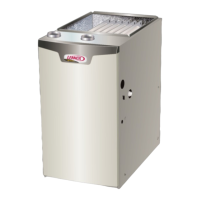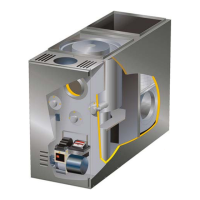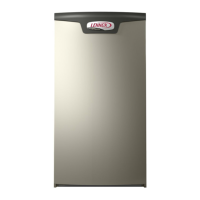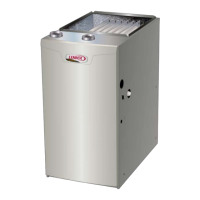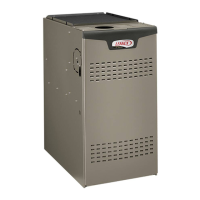Page 55
2 - Once the control receives a signal that the low-
re pressure switch has closed, the combustion
air inducer begins a 15-second pre-purge in the
ignition speed.
3 - After the pre-purge is complete, a 20-second initial
ignitor warm-up period begins. The combustion air
inducer continues to operate at the ignition speed.
4 - After the 20-second warm-up period has ended,
the gas valve is energized and ignition occurs. At
the same time, the control module sends a signal to
begin an indoor blower 45-second ON delay. When
the delay ends, the indoor blower motor is energized
at a speed that matches the ring rate. After the
10-second ignition stabilization delay expires, the
inducer speed is adjusted to the appropriate target
rate. The inducer will remain at the 70 percent
speed as long as the thermostat has a rst-stage
heating demand.
5 - second-stage heat is required, the thermostat
second- stage heat contacts close and send a signal
to the integrated control. The integrated control
initiates a 30-second second-stage recognition
delay.
6 - At the end of the recognition delay and for all
subsequent calls for second-stage heat, the
integrated control energizes the combustion air
inducer at high speed. The control also checks the
high-re pressure switch to make sure it is closed.
As the inducer speed is increased to high, the
indoor blower motor is adjusted to a speed which is
appropriate for secondstage heat.
7 - When the demand for high-re (second stage) heat
is satised, the gas valve is de-energized and the
eldselected indoor blower o delay begins. The
combustion air inducer begins a 20-second post-
purge period.
8 - When the combustion air post-purge period is
complete, the inducer is de-energized. The indoor
blower is de-energized at the end of the o delay.
Applications Using a Two-Stage Thermostat
B - Heating Sequence -- Control Thermostat Selection
DIP switch in “Variable Capacity” Position
1 - On a call for heat, thermostat rst-stage contacts
close sending a signal to the integrated control. The
integrated control runs a self-diagnostic program
and checks high temperature limit switches for
normally closed contacts and pressure switches
for normally open contacts. The combustion air
inducer is energized at ignition speed, which is
approximately the same as the inducer speed at 70
percent ring rate.
2 - Once the control receives a signal that the low-re
pressure switch has closed, the combustion air
inducer begins a 15-second pre-purge in low speed.
3 - After the pre-purge is complete, a 20-second initial
ignitor warm-up period begins. The combustion air
inducer continues to operate at the ignition speed.
4 - After the 20-second warm-up period has ended,
the gas valve is energized and ignition occurs.At
the same time, the control module begins an indoor
blower 45-second ON delay. When the delay ends,
the indoor blower motor is energized at a speed that
matches the ring rate. After the 10-second ignition
stabilization delay expires, the inducer speed is
adjusted to the appropriate target rate. If the furnace
is operating in the initial heating cycle after power-
up, the initial ring rate will be approximately 35
percent. The ring rate on subsequent cycles will
be automatically adjusted by the integrated control
based on thermostat cycles. The ring rate will vary
and will range from 35 percent to 90 percent. The
furnace will continue this operation as long as the
thermostat has a rst-stage heating demand.
5 - If second-stage heat is required, the thermostat
second- stage heat contacts close and send a signal
to the integrated control. The integrated control
either increases the ring rate to 70 percent (if the
current rate is at or below 60 percent) or increases
the ring rate by 10 percent (if the current rate is
above 60 percent). If the call for heat continues 5
minutes beyond this initial upstage, the rate will
be increased by 10 percent every 5 minutes until
the call for heat is satised or the furnace reaches
100 percent rate. As the ring rate increases, the
indoor blower motor is adjusted to a speed which is
appropriate for the target rate.
6 - If second-stage heat demand is satised, but rst
stage is still present, the furnace will continue to
operate at the present ring rate until the heat cycle
ends.
7 - When the demand for rst- and second-stage heat
is satised, the gas valve is de-energized and the
eldselected indoor blower o delay begins. The
combustion air inducer begins a 20-second post-
purge period.
8 - When the combustion air post-purge period is
complete, the inducer is de-energized. The indoor
blower is de-energized at the end of the o delay.
Applications Using A Single-Stage Thermostat
C - Heating Sequence -- Control Thermostat Selection
DIP switch in “Single-Stage” Position
1 - On a call for heat, thermostat rst-stage contacts
close sending a signal to the integrated control. The
integrated control runs a self-diagnostic program
and checks high temperature limit switches for
normally closed contacts and pressure switches
for normally open contacts. The combustion air
inducer is energized at the ignition speed, which is
approximately the same as the inducer speed at 70
percent ring rate.
2 - Once the control receives a signal that the low-
re pressure switch has closed, the combustion
air inducer begins a 15-second pre-purge at the
ignition speed.
3 - After the pre-purge is complete, a 20-second initial
ignitor warm-up period begins. The combustion air
inducer continues to operate at the ignition speed.
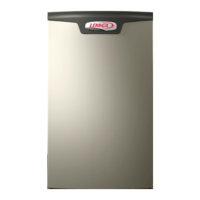
